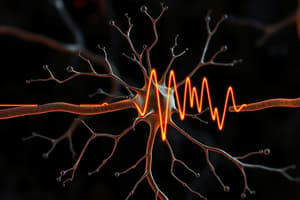Podcast
Questions and Answers
Which ion has a higher concentration inside the neuron, contributing to the resting membrane potential?
Which ion has a higher concentration inside the neuron, contributing to the resting membrane potential?
- Potassium (K+) (correct)
- Chloride (Cl-)
- Calcium (Ca2+)
- Sodium (Na+)
What occurs during depolarization of a neuronal membrane?
What occurs during depolarization of a neuronal membrane?
- The membrane becomes more polarized.
- The concentration of K+ ions outside the cell increases.
- The membrane potential increases towards 0 mV. (correct)
- The membrane potential decreases below -70 mV.
What is the typical range of resting potential in most neurons?
What is the typical range of resting potential in most neurons?
- -40 mV to -50 mV
- -70 mV to -80 mV
- -10 mV to 0 mV
- -60 mV to -70 mV (correct)
What is the primary function of the sodium-potassium pump (Na+/K+ ATPase)?
What is the primary function of the sodium-potassium pump (Na+/K+ ATPase)?
How does hyperpolarization affect the neuronal membrane potential?
How does hyperpolarization affect the neuronal membrane potential?
What does the Goldman Equation calculate in relation to neuronal membrane potential?
What does the Goldman Equation calculate in relation to neuronal membrane potential?
What is the primary ionic factor contributing to the negative charge within a neuron at rest?
What is the primary ionic factor contributing to the negative charge within a neuron at rest?
Which of the following describes polarization in a neuronal membrane?
Which of the following describes polarization in a neuronal membrane?
Flashcards are hidden until you start studying
Study Notes
Resting Potential: Neuronal Membrane Potential
-
Definition: Resting potential is the electrical potential difference across the neuronal membrane when the neuron is not actively transmitting a signal.
-
Typical Value:
- Ranges from -60 mV to -70 mV (millivolts) in most neurons.
-
Key Terms:
- Polarization: The state of having a difference in charge across the membrane.
- Depolarization: Reduction in the membrane potential towards 0 mV, making the inside of the cell less negative.
- Hyperpolarization: Increase in the membrane potential beyond the resting state, making the inside of the cell more negative.
-
Ionic Basis:
- The resting potential is primarily determined by the concentrations of ions, especially:
- Potassium (K+): Higher concentration inside the cell; contributes to the negative charge.
- Sodium (Na+): Higher concentration outside the cell; less influence at rest due to limited permeability.
- Chloride (Cl-): Generally higher outside, but its role varies depending on the type of neuron.
- Calcium (Ca2+): Also higher outside; plays a role in signaling but less in resting potential.
- The resting potential is primarily determined by the concentrations of ions, especially:
-
Membrane Permeability:
- The neuronal membrane is more permeable to K+ ions at rest, allowing them to move out of the cell, which contributes to the negative internal charge.
- The sodium-potassium pump (Na+/K+ ATPase) actively transports 3 Na+ ions out of the cell and 2 K+ ions into the cell, maintaining the concentration gradient.
-
Goldman Equation:
- Used to calculate the resting membrane potential considering the permeability of different ions.
- Takes into account the relative concentrations and permeability of Na+, K+, and Cl- ions.
-
Functional Importance:
- Sets the stage for action potentials and neuronal excitability.
- Essential for signal transduction and communication between neurons.
-
Changes in Resting Potential:
- Can be influenced by various factors such as neurotransmitter activity, ion channel function, and overall neuronal health.
- Pathological conditions can alter resting potential, affecting neuronal function.
Understanding resting potential is crucial for studying neuronal activity, synaptic transmission, and overall nervous system function.
Resting Potential Definition
- Electrical potential difference across the neuronal membrane when inactive.
- Reflects the neuron's readiness to transmit signals.
Typical Value
- Common resting potential values range from -60 mV to -70 mV.
Key Terms
- Polarization: Indicates a charge difference across the neuron's membrane.
- Depolarization: A shift toward 0 mV; reduces negativity inside the neuron.
- Hyperpolarization: A potential increase beyond resting state; increases negativity inside the neuron.
Ionic Basis
- Potassium (K+): High concentration inside the cell; contributes to negative internal charge.
- Sodium (Na+): Predominantly outside the cell; limited permeability at rest influences its role.
- Chloride (Cl-): Typically higher outside; role varies among neuron types.
- Calcium (Ca2+): Higher levels outside; significant for signaling rather than resting potential.
Membrane Permeability
- Neuronal membrane demonstrates higher permeability to K+ ions, facilitating their movement out, which maintains a negative internal charge.
- The sodium-potassium pump (Na+/K+ ATPase) enables active transport, moving 3 Na+ ions out and 2 K+ ions in, sustaining concentration gradients.
Goldman Equation
- A formula used to calculate resting membrane potential by factoring in the permeability of various ions.
- Evaluates relative concentrations and permeabilities of Na+, K+, and Cl- ions.
Functional Importance
- Establishes a baseline for action potentials and contributes to neuronal excitability.
- Critical for signal transduction and communication across neurons.
Changes in Resting Potential
- Influenced by factors such as neurotransmitter action, ion channel functionality, and the overall condition of the neuron.
- Pathological states can disrupt resting potential, leading to impaired neuronal functions.
Relevance
- Understanding resting potential is essential for exploring neuronal activity, synaptic transmission, and the overall function of the nervous system.
Studying That Suits You
Use AI to generate personalized quizzes and flashcards to suit your learning preferences.




